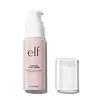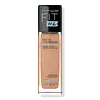What's inside
What's inside
 Key Ingredients
Key Ingredients

 Benefits
Benefits

 Concerns
Concerns

 Ingredients Side-by-side
Ingredients Side-by-side

Water
Skin ConditioningCyclohexasiloxane
EmollientNylon-12
Isododecane
EmollientAlcohol Denat.
AntimicrobialCyclopentasiloxane
EmollientPEG-10 Dimethicone
Skin ConditioningCetyl PEG/PPG-10/1 Dimethicone
EmulsifyingPEG-20
HumectantPolyglyceryl-4 Isostearate
EmulsifyingDisteardimonium Hectorite
StabilisingPhenoxyethanol
PreservativeMagnesium Sulfate
Disodium Stearoyl Glutamate
CleansingHdi/Trimethylol Hexyllactone Crosspolymer
Titanium Dioxide
Cosmetic ColorantMethylparaben
PreservativeAcrylates Copolymer
Tocopherol
AntioxidantButylparaben
MaskingAluminum Hydroxide
EmollientAlumina
AbrasiveSilica
AbrasiveGlycerin
HumectantCI 77891
Cosmetic ColorantCI 77491
Cosmetic ColorantCI 77492
Cosmetic ColorantCI 77499
Cosmetic ColorantCeramide AP
Skin ConditioningWater, Cyclohexasiloxane, Nylon-12, Isododecane, Alcohol Denat., Cyclopentasiloxane, PEG-10 Dimethicone, Cetyl PEG/PPG-10/1 Dimethicone, PEG-20, Polyglyceryl-4 Isostearate, Disteardimonium Hectorite, Phenoxyethanol, Magnesium Sulfate, Disodium Stearoyl Glutamate, Hdi/Trimethylol Hexyllactone Crosspolymer, Titanium Dioxide, Methylparaben, Acrylates Copolymer, Tocopherol, Butylparaben, Aluminum Hydroxide, Alumina, Silica, Glycerin, CI 77891, CI 77491, CI 77492, CI 77499, Ceramide AP
 Reviews
Reviews

Ingredients Explained
These ingredients are found in both products.
Ingredients higher up in an ingredient list are typically present in a larger amount.
Ci 77891 is a white pigment from Titanium dioxide. It is naturally found in minerals such as rutile and ilmenite.
It's main function is to add a white color to cosmetics. It can also be mixed with other colors to create different shades.
Ci 77891 is commonly found in sunscreens due to its ability to block UV rays.
Learn more about CI 77891Phenoxyethanol is a preservative that has germicide, antimicrobial, and aromatic properties. Studies show that phenoxyethanol can prevent microbial growth. By itself, it has a scent that is similar to that of a rose.
It's often used in formulations along with Caprylyl Glycol to preserve the shelf life of products.
Silica, also known as silicon dioxide, is a naturally occurring mineral. It is used as a fine, spherical, and porous powder in cosmetics.
Though it has exfoliant properties, the function of silica varies depending on the product.
The unique structure of silica enhances the spreadability and adds smoothness, making it a great texture enhancer.
It is also used as an active carrier, emulsifier, and mattifier due to its ability to absorb excess oil.
In some products, tiny microneedles called spicules are made from silica or hydrolyzed sponge. When you rub them in, they lightly polish away dead skin layers and enhance the penetration of active ingredients.
Learn more about Silica